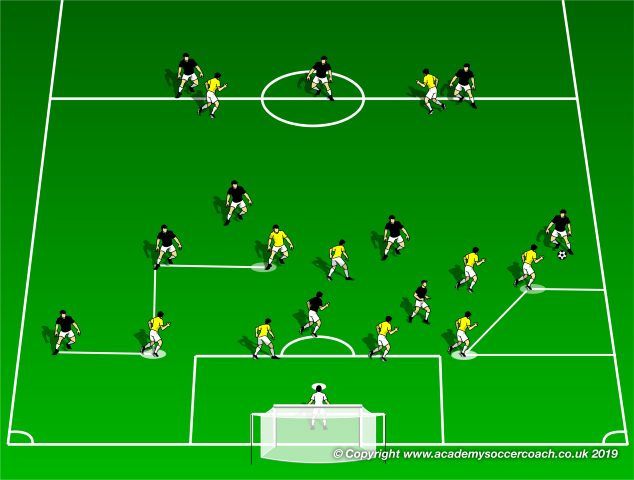WORLD CLASS COACHING
4-3-3 Attacking
By Luca Bertolini
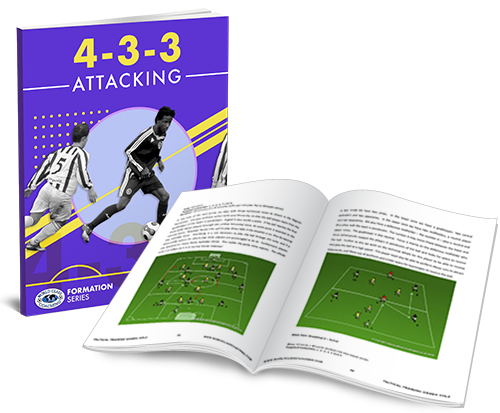
Table of Contents
PART ONE
Introduction
Basic Principles of Play With the Ball
PART TWO
Possession and Key Attacking Principles
Movement Without the Ball - Variation of Runs
PART THREE
Players/Positions Roles and Responsibilities
PART FOUR
4-3-3 History, Different Line Ups and Applications
Introduction
A 1-4-3-3 team formation is usually set-up with 3 player lines with a balanced spread of them over the pitch, shaping ‘triangles’ and creating good conditions for possession and attacking style of play.

These are the main pros from an offensive point of view:
• Effective positional play thanks to the players' triangles; this way all the ball carriers have always a forward support, a back or side option for a pass time to time.

• Easy building up and playing out patterns and passing options, exploiting the half spaces with at least 2 players on each side (with a center forward); in this example, the half spaces are covered with 1 player inside each part and each half of the pitch, as the CM has drop deep between the CBs and the middle third is managed by the outer midfielders. The wingers run inside to create space for the fullbacks.
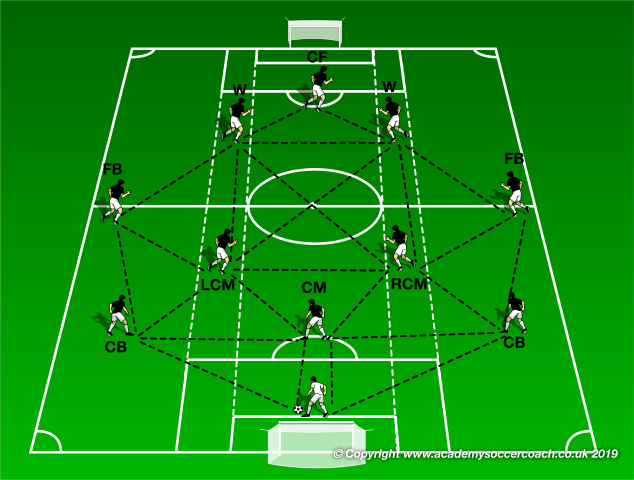
• False 9 variation: as the striker plays as false 9, in between the lines, the outer midfielders stand higher on the field, to overload the center; the lower pivot drops deep between the CBs and who doesn't receive from the goalkeeper, he must cover the half space in front of him, accepting a potential 2 v 2 duel, as the receiver should try to play/dribble forward.
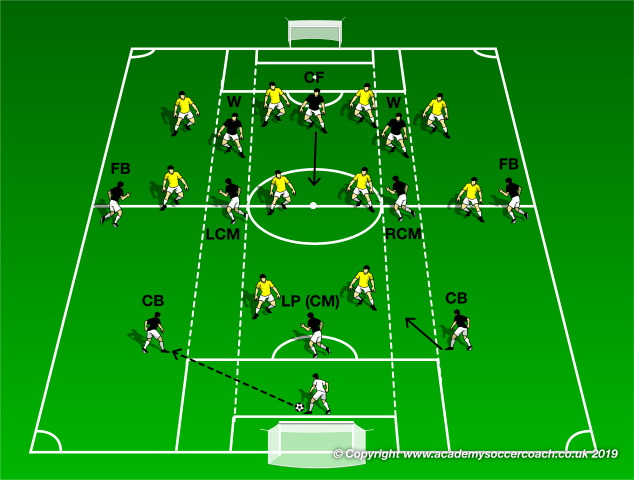
• The center midfielder can be a lower pivot, shaping a midfield triangle with a lower point (this is the usual shape to start the famous "La Volpe Exit" with the lower pivot in between the CBs who move wide and the fullbacks push up and wide toward the middle third)...
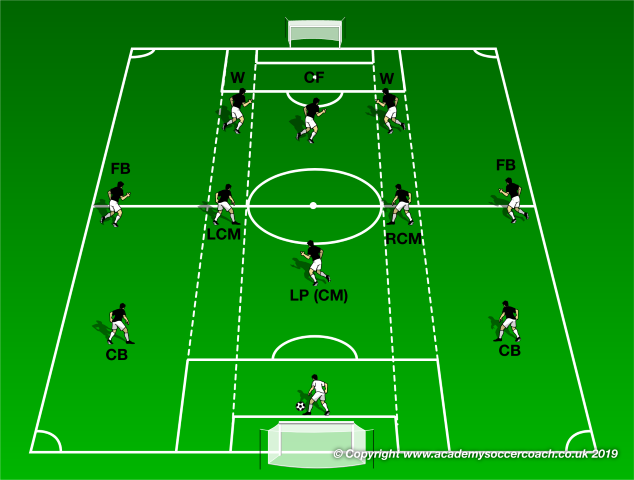
...Or an advanced midfielder, (shaping a different kind of triangle in the middle third, more similar to 1-4-2-3-1 formation). In this option, one of the outer midfielders usually becomes the balance player in front of the CBs to save the defensive half preemptively. The half spaces can be exploited by an inverted fullback together with the wingers or even by the advanced midfielder following the ball position.
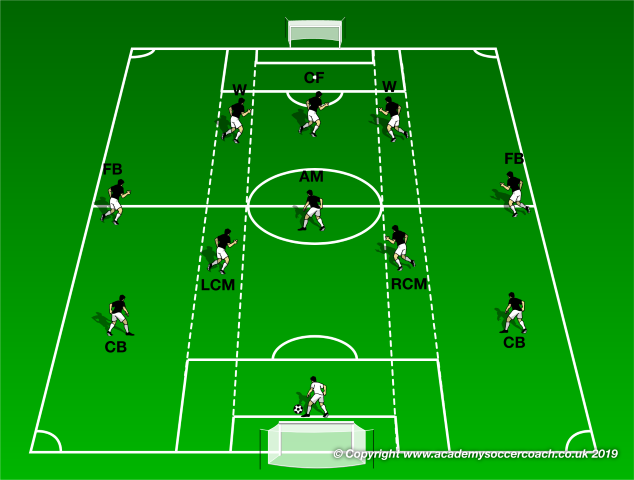
• A back, a forward, and a wide support for the ball carrier are used to maintain possession. Every ball carrier should have as many options as possible to progress the move or to save the possession during transitions to attack or when under pressure. The best situation possible, if the player in possession were a point (LCM), is to have a forward option to overcome an opposition line with a through pass (W), a wide option to overcome the opposition line sideways (FB), an internal option to favor a switch side of play or to give the teammates more time play (CM) and a back pass option to avoid the opposition pressure (CB).
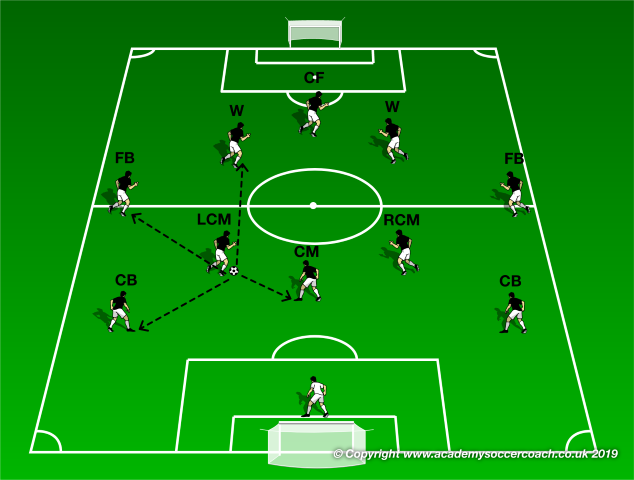
• At least 1 player who can always move between the opposition defense lines; this movements are easier in a 1-4-3-3 starting shape; in this example, the new triangle, moving in between the lines are shaped by RCM+CF+W, RCM+CF+FB or LP+CF+LCM.
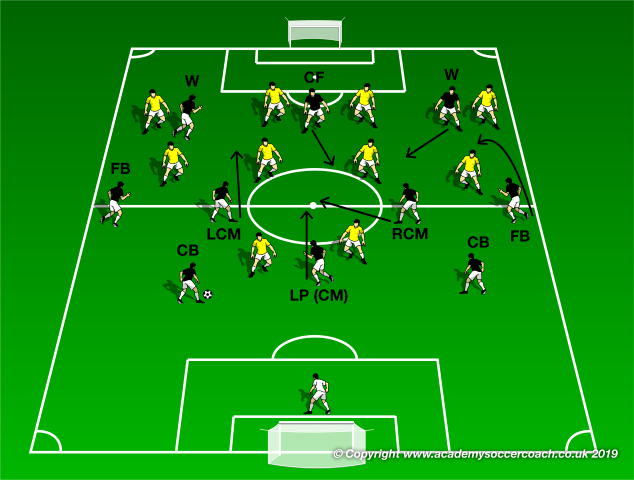
• Easy and quick combinations through short passing sequences thanks to positional play; 1-4-3-3 is very helpful to create groups of 3 or 4 players who can manage the possession and progress the move. The center positional play combinations are usually shaped by CM + LCM & RCM (+ CF if he drops back) and by LCM+RCM + CF & Ws inside the final third. Wide combinations of play are usually shaped by CB+FB+CM & the outer CM and by FB+CM & W.
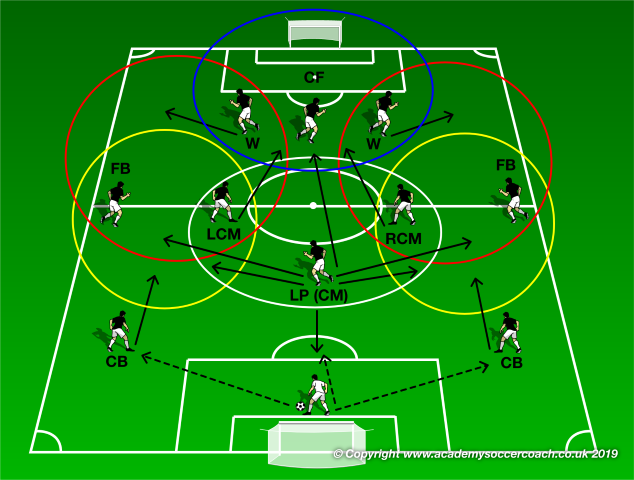
• Creative and varied attacking play using the width of the field. As the current tendency is to overload a flank (or a specific zone of field) to switch the side or play out toward a weak area into the opposition defensive shape, when attacking phase of 1-4-3-3 is shaped in a 1-3-4-3 inside the opposition half, a 3 v 2 duel is very easy to create along the opposite flank from the ball position.
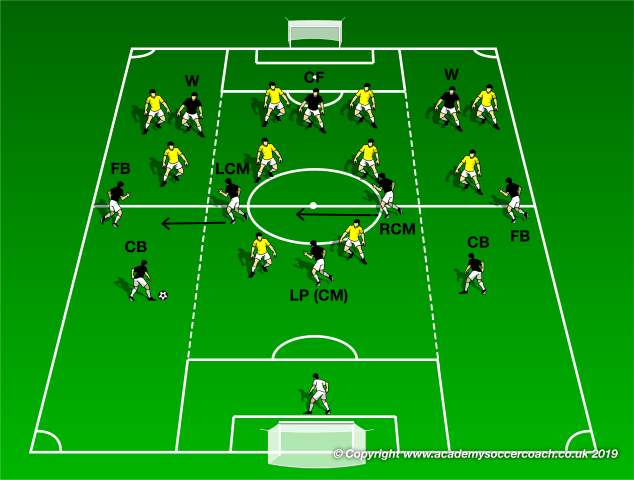
• Wide wingers beside the center forward (wingers are decisive, as if they are usually placed wide, they must provide width before running inside; in this case, the outer midfielders are free to run through the opposition defense shapes to receive in behind)...
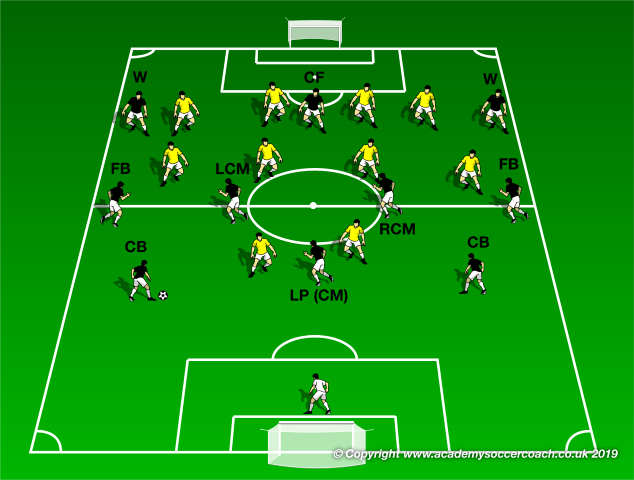
...Narrow wide forwards are placed behind the center one (if the wingers play more as second forwards, then the fullbacks will provide width and the outer midfielders must cover them along the flanks)...
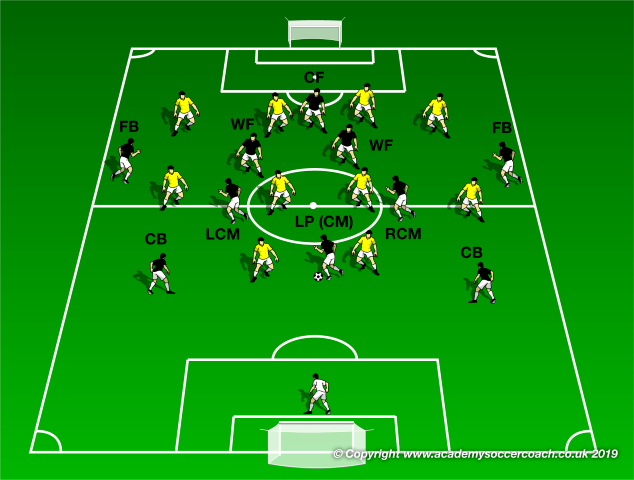
...Or one advanced midfielder is placed behind two center forwards (the advanced midfielders must play between the opposition line, the width is again provided by the fullbacks and the outer midfielders stand along the half spaces).

• Advanced center striker or "false nine" option.
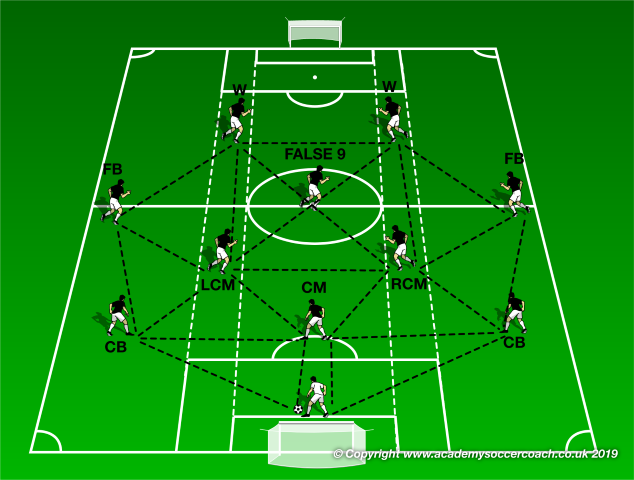
Basic attacking principles of play
The commonly recognized attacking principles of play in soccer are:
• Penetration: to break through the opposition pressure lines or to find a gap in the positional play inside the first third and middle third to save the possession while progressing the move by passing, receiving, dribbling and running without the ball and through the last opposition defense line to finish by passing, receiving, dribbling and running without the ball and shooting, taking the defending players out of positions.
• Mobility: players make runs into different areas of the field in order to invite the defenders out of their positions or to create numerical advantage near the ball, following the positional play style of the team. It's very important to make different movements when 2 potential receivers are placed in front of the ball carrier:
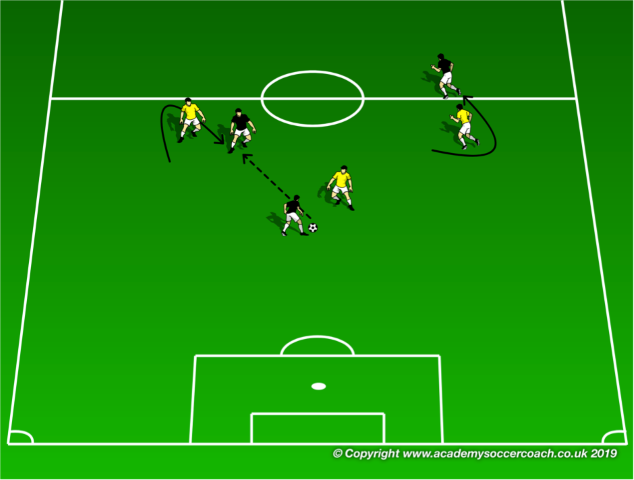
Mobility through right timing runs is effective when the team can:
• Create numerical advantage around the ball zone
• Create triangles and rhombuses
• Shape and maintain width with wingers and fullbacks.
• Shape and maintain depth; centre backs should create options when midfielders can¬not play forward and midfielders when attackers cannot play forward in the final third.
• Create diagonal passes options during the first and middle third build-up and vertical passes and combinations options in the final third.
• Support: a player of the possession team receives a pass and he must maintain the possession, the teammates provide backward and sideways options to the player in possession. The main goal of the support actions is to save the possession, passing sideways to move the opponents or the nearest opposition pressure line or backward to save the possession, looking for new spaces or a switch of side.
Two important principles to maintain the possession are width and depth.
• Depth: when a player of the possession team receives a pass and he must progress the move toward the next third of the field, the teammates provide forward options to the player in possession. The main goal is to move the ball forward, overcoming an opposition line or player to arrive as quickly as possible near the opposition goal, taking the attacking phase to the finishing stage or to a shoot on goal. When the fullbacks and centre midfielders have possession depth comes from centre-backs and goalkeeper but also from the centre forward. Making the field as big as possible when in possession with maxi¬mum width and depth is important not only to create space for yourself but also to create space for others to play in or to exploit by moving into.
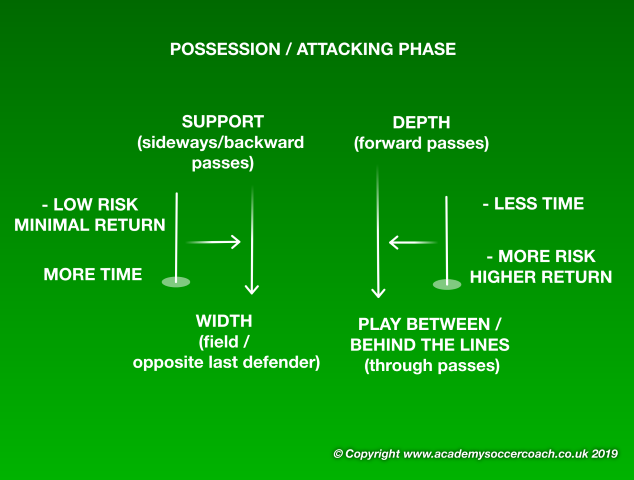
• Width: the attacking team attempts to stretch the opponent’s defensive or pressure shape using the width of the field, the wider point of the opposition lines (the opposite last defender form the ball position) or the distances between and among the opponents.
The goal is to invite the defenders out from a compact shape while covering the dangerous areas in front of goal, creating space. The attackers move the ball to change the point of attack to find a space between or behind the defense.
When playing a 1-4-3-3 system the width when in possession inside the first third should come from the fullbacks and from the wingers. When a fullback receives the ball, the centre back must drop off to create depth and as a result, space to maintain possession if a forward option is not available.
As the play develops into the middle and final thirds, fullbacks should provide the width together with the wingers, who have more freedom to make diagonal runs and interchanges of positions with the centre forward.
• Width of the field: this is the classic definition, with a player (usually fullbacks and wingers) who touches the sideline to stretch the opposition defense block. If it's possible the pass should be received at the back of the opponent and with a teammate in front of the receiver who creates space forward.
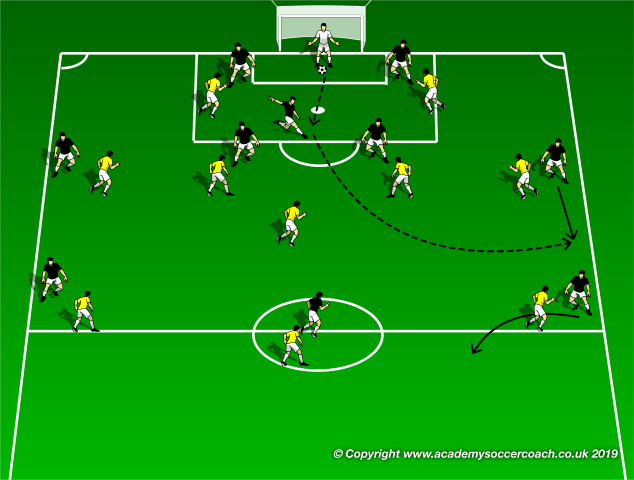
• The wider point of the opposition lines: width can be also created by pinning the wider player of the opposition along the opposite flank from the ball position, to create space wider for an overlapping teammate.
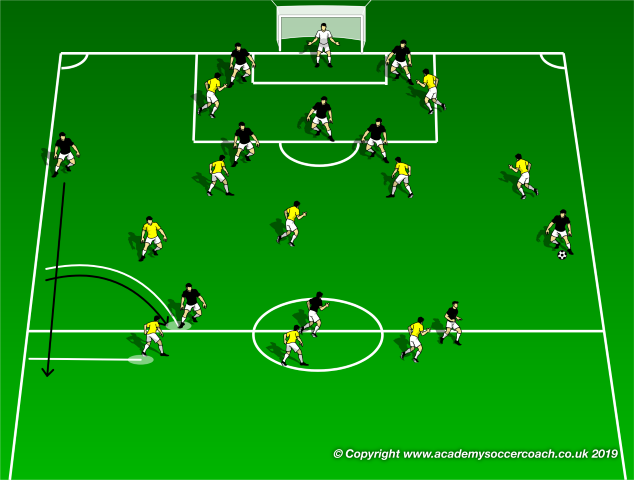
• The distances between and among the opponents: every player who can dribble past the direct opponent is providing width. Every player who can receive a pass unmarked square to or next to the opponents between him and the sidelines is providing width.
